
In Ancient Roman architecture, a basilica was a large public building with multiple functions that was typically built alongside the town's forum. The basilica was in the Latin West equivalent to a stoa in the Greek East. The building gave its name to the basilica architectural form.

The Roman Forum, also known by its Latin name Forum Romanum, is a rectangular forum (plaza) surrounded by the ruins of several important ancient government buildings at the centre of the city of Rome. Citizens of the ancient city referred to this space, originally a marketplace, as the Forum Magnum, or simply the Forum.
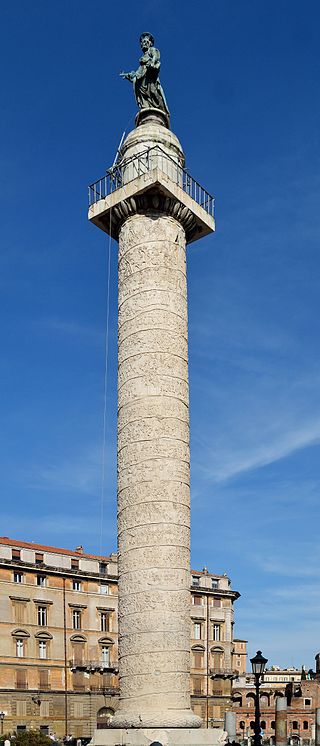
Trajan's Column is a Roman triumphal column in Rome, Italy, that commemorates Roman emperor Trajan's victory in the Dacian Wars. It was probably constructed under the supervision of the architect Apollodorus of Damascus at the order of the Roman Senate. It is located in Trajan's Forum, north of the Roman Forum. Completed in AD 113, the freestanding column is most famous for its spiral bas relief, which depicts the wars between the Romans and Dacians. Its design has inspired numerous victory columns, both ancient and modern.

The Rostra was a large platform built in the city of Rome that stood during the republican and imperial periods. Speakers would stand on the rostra and face the north side of the Comitium towards the senate house and deliver orations to those assembled in between. It is often referred to as a suggestus or tribunal, the first form of which dates back to the Roman Kingdom, the Vulcanal.

The Arch of Constantine is a triumphal arch in Rome dedicated to the emperor Constantine the Great. The arch was commissioned by the Roman Senate to commemorate Constantine's victory over Maxentius at the Battle of Milvian Bridge in AD 312. Situated between the Colosseum and the Palatine Hill, the arch spans the Via Triumphalis, the route taken by victorious military leaders when they entered the city in a triumphal procession. Dedicated in 315, it is the largest Roman triumphal arch, with overall dimensions of 21 m (69 ft) high, 25.9 m (85 ft) wide and 7.4 m (24 ft) deep. It has three bays, the central one being 11.5 m (38 ft) high and 6.5 m (21 ft) wide and the laterals 7.4 m (24 ft) by 3.4 m (11 ft) each. The arch is constructed of brick-faced concrete covered in marble.

The Ficus Ruminalis was a wild fig tree that had religious and mythological significance in ancient Rome. It stood near the small cave known as the Lupercal at the foot of the Palatine Hill and was the spot where according to tradition the floating makeshift cradle of Romulus and Remus landed on the banks of the Tiber. There they were nurtured by the she-wolf and discovered by Faustulus. The tree was sacred to Rumina, one of the birth and childhood deities, who protected breastfeeding in humans and animals. St. Augustine mentions a Jupiter Ruminus.

The Temple of Caesar or Temple of Divus Iulius, also known as Temple of the Deified Julius Caesar, delubrum, heroon or Temple of the Comet Star, is an ancient structure in the Roman Forum of Rome, Italy, located near the Regia and the Temple of Vesta.

The Imperial Fora are a series of monumental fora, constructed in Rome over a period of one and a half centuries, between 46 BC and 113 AD. The fora were the center of the Roman Republic and of the Roman Empire.

Trajan's Forum was the last of the Imperial fora to be constructed in ancient Rome. The architect Apollodorus of Damascus oversaw its construction.
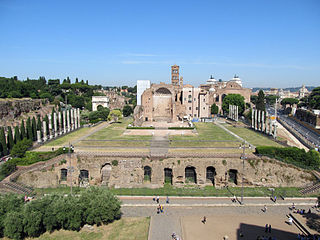
The Temple of Venus and Roma is thought to have been the largest temple in Ancient Rome. Located on the Velian Hill, between the eastern edge of the Forum Romanum and the Colosseum, in Rome, it was dedicated to the goddesses Venus Felix and Roma Aeterna.
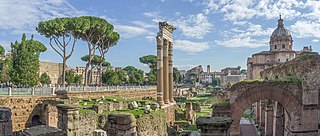
The Forum of Caesar, also known by the Latin Forum Iulium or Forum Julium, Forum Caesaris, was a forum built by Julius Caesar near the Forum Romanum in Rome in 46 BC.
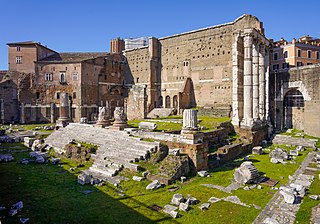
The Temple of Mars Ultor was a sanctuary erected in Ancient Rome by the Roman Emperor Augustus in 2 BCE and dedicated to the god Mars in his guise as avenger. The centerpiece of the Forum of Augustus, it was a peripteral style temple, on the front and sides, but not the rear, raised on a platform and lined with eight columns in the Corinthian order style.

The Basilica Ulpia was an ancient Roman civic building located in the Forum of Trajan. The Basilica Ulpia separates the temple from the main courtyard in the Forum of Trajan with the Trajan's Column to the northwest. It was named after Roman emperor Trajan whose full name was Marcus Ulpius Traianus.

The Comitium was the original open-air public meeting space of Ancient Rome, and had major religious and prophetic significance. The name comes from the Latin word for "assembly". The Comitium location at the northwest corner of the Roman Forum was later lost in the city's growth and development, but was rediscovered and excavated by archaeologists at the turn of the twentieth century. Some of Rome's earliest monuments; including the speaking platform known as the Rostra, the Columna Maenia, the Graecostasis and the Tabula Valeria were part of or associated with the Comitium.
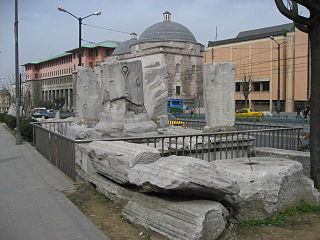
The Forum of Theodosius was probably the largest square in Constantinople and stood on the Mese, the major road that ran west from Hagia Sophia. It was originally built by Constantine I, probably on the site of a pre-existing Hellenistic agora called the Strategion, and named the Forum Tauri. In 393, however, it was renamed after Emperor Theodosius I, who rebuilt it after the model of Trajan's Forum in Rome, surrounded by civic buildings such as churches and baths and decorated with a triumphal column at its centre.
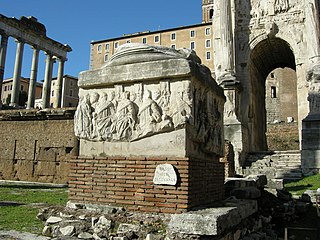
The Five-Columns monument is a dedicatory addition to the Rostra in the Roman Forum dating to the early fourth century CE. This monument was part of the Tetrarchy's expansion of the Forum and is connected to the tenth anniversary of the Caesares within the four-ruler system. It is also referred to as the Fünfsäulendenkmal as well as the four-column monument, depending on Jupiter's inclusion.
Trajanic art is the artistic production of the Roman Empire during the reign of Emperor Trajan from 98 to 117. In this period, Roman art further developed the innovations of the Flavian era, coming to definitively detach itself from Hellenistic influence.

The Regio VIII Forum Romanum Magnum is the eighth regio of imperial Rome, under Augustus's administrative reform. Regio VIII took its name from the Roman Forum, the political centre of Ancient Rome.

















